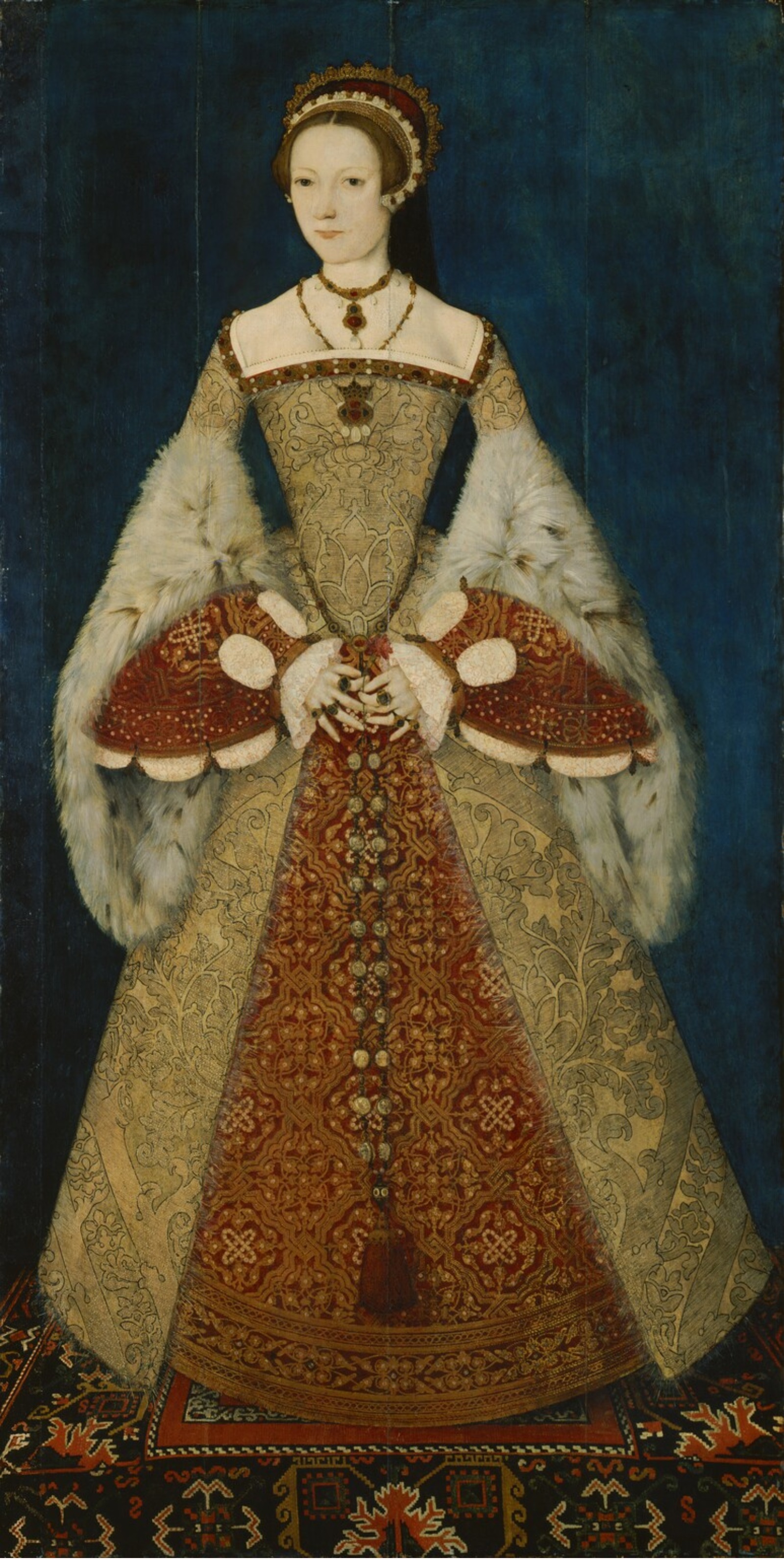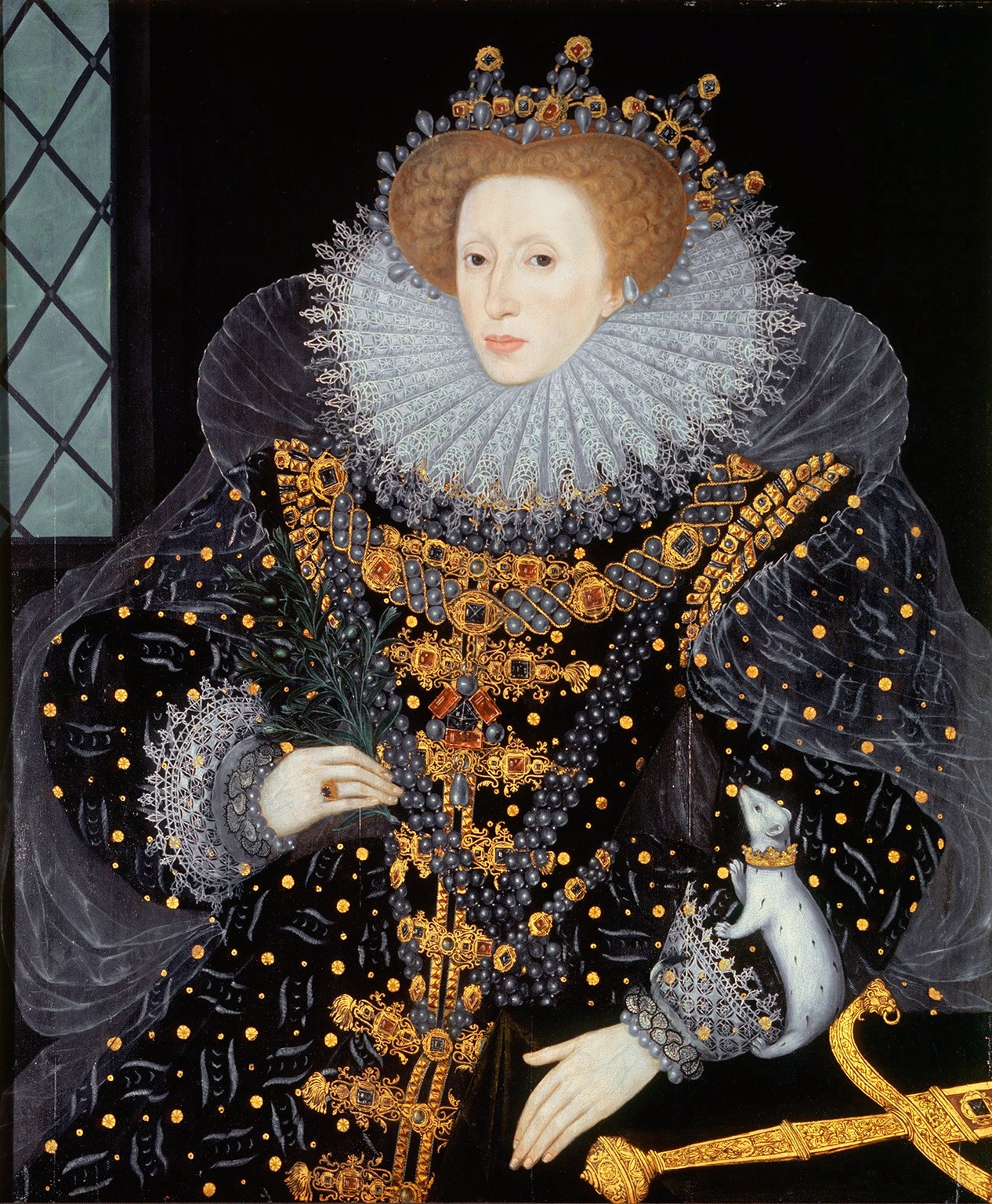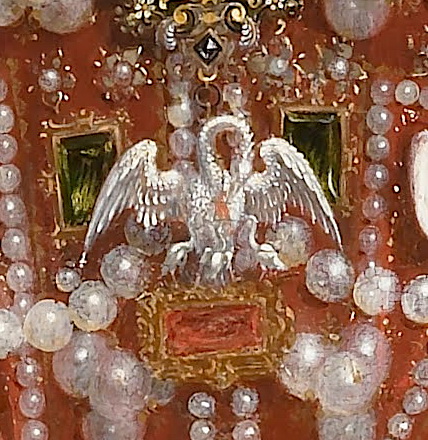|
Partlet
A partlet or partlett was a 16th century fashion accessory. The partlet was a sleeveless garment worn over the neck and shoulders, either worn over a dress or worn to fill in a low neckline. The earliest partlets appeared in late 15th century fashion. They were made of silk or linen, and were worn to fill in the low necklines of both men's and women's Burgundian dress. Men continued to wear partlets, usually of rich materials, with the low-cut doublets of the early 16th century. Early 16th century women's partlets were made in a variety of fabrics and colors, although black was most popular. Black partlets worn over the gown, usually of velvet or satin for the upper classes, are an earlier style. A wardrobe warrant of June 1538 ordered black velvet for a "French partlet" for Princess Mary.Hayward (2007), p. 166 These black partlets may be seen in a number of portraits of Tudor court ladies by Hans Holbein the Younger, as well as in Dutch paintings of market women throughout th ... [...More Info...] [...Related Items...] OR: [Wikipedia] [Google] [Baidu] |
1500–1550 In Western European Fashion
Fashion in the period 1500–1550 in Western Europe is marked by very thick, big and voluminous clothing worn in an abundance of layers (one reaction to the cooling temperatures of the Little Ice Age, especially in Northern Europe and the British Isles). Contrasting fabrics, slashes, embroidery, applied trims, and other forms of surface ornamentation became prominent. The tall, narrow lines of the late Medieval period were replaced with a wide silhouette, conical for women with breadth at the hips and broadly square for men with width at the shoulders. Sleeves were a center of attention, and were puffed, slashed, cuffed, and turned back to reveal contrasting linings. Henry VIII of England (ruled 1509–1547) and Francis I of France (ruled 1515–1547) strove to host the most glittering renaissance court, culminating in the festivities around the Field of Cloth of Gold (1520). But the rising power was Charles V, king of Spain, Naples, and Sicily from 1516, heir to the style as we ... [...More Info...] [...Related Items...] OR: [Wikipedia] [Google] [Baidu] |
1550–1600 In Western European Fashion
Fashion in the period 1550–1600 in Western European clothing was characterized by increased opulence. Contrasting fabrics, slashes, embroidery, applied trims, and other forms of surface ornamentation remained prominent. The wide silhouette, conical for women with breadth at the hips and broadly square for men with width at the shoulders had reached its peak in the 1530s, and by mid-century a tall, narrow line with a V-lined waist was back in fashion. Sleeves and women's skirts then began to widen again, with emphasis at the shoulder that would continue into the next century. The characteristic garment of the period was the ruff, which began as a modest ruffle attached to the neckband of a shirt or smock and grew into a separate garment of fine linen, trimmed with lace, cutwork or embroidery, and shaped into crisp, precise folds with starch and heated irons. General trends Spanish style Charles V, king of Spain, Naples, and Sicily and Holy Roman Emperor, handed over ... [...More Info...] [...Related Items...] OR: [Wikipedia] [Google] [Baidu] |
1400–1500 In European Fashion
Fashion in 15th-century Europe was characterized by a series of extremes and extravagances, from the voluminous robes called houppelandes with their sweeping floor-length sleeves to the revealing doublets and hose of Renaissance Italy. Hats, hoods, and other headdresses assumed increasing importance, and were draped, jewelled, and feathered. As Europe continued to grow more prosperous, the urban middle classes, skilled workers, began to wear more complex clothes that followed, at a distance, the fashions set by the elites. It is in this time period that we begin to see fashion take on a temporal aspect. People could now be dated by their clothes, and being in "out of date" clothing became a new social concern. National variations in clothing seem on the whole to have increased over the 15th century.Boucher, François: ''20,000 Years of Fashion'', Harry Abrams, 1966. General trends New trends emerge among the Danes The Lübeckian chronicler Arnold mocked changes in Danish att ... [...More Info...] [...Related Items...] OR: [Wikipedia] [Google] [Baidu] |
Silkwoman
A silkwoman was a woman in medieval, Tudor, and Stuart England who traded in silks and other fine fabrics. London silkwomen held some trading rights independently from their husbands and were exempted from some of the usual customs and laws of coverture. The trade and craft of the silkwoman was encouraged by a statute of Henry VI of England as a countermeasure to imports of silk thread, and a suitable occupation for "young gentlewomen and other apprentices". Silkwomen in London In 1421 Alice Corsmaker paid 6s-8d to the Mercer's Company of London to trade as a silkwoman. Alice Bradbridge was recognised as a "sister" of the Worshipful Company of Drapers. Silkwomen in London manufactured silk thread from raw silk imported from Italy, wove and sold ribbons, braids, cord, girdles, and trimmings, called "narrow ware", and made other silk goods. In the Elizabeth period, silkwomen also provided linen goods including lawn sleeves and partlets. Silkwomen supplying the royal wardrobe An ... [...More Info...] [...Related Items...] OR: [Wikipedia] [Google] [Baidu] |
Guimpe
The guimpe (from the French ''guimpe)'' was a garment which developed in medieval Western Europe. It was a silk or linen kerchief, sometimes sheer, sometimes starched, which covered the neck and shoulders of the wearer, sometimes the entire chest as well. It was worn as part of the apparel of a woman of means, both to show social standing—due to the added upkeep it required—and to demonstrate the woman's sense of modesty. Among nuns it was worn in combination with a coif and wimple. As women in Renaissance Italy began to leave their heads uncovered, and to expose their shoulders, the guimpe slowly fell into disuse. Its use continued solely in monasteries, as part of a nun's religious habit. As women's religious Orders began to adopt contemporary attire, it has largely disappeared from these circles as well. From the early nineteenth century onwards, the term guimpe also described a form of short under-blouse or chemisette A chemisette (from French, "little chemise") is an ... [...More Info...] [...Related Items...] OR: [Wikipedia] [Google] [Baidu] |
Pelican Portrait
The Pelican Portrait is an oil painting of Elizabeth I of England on a wood panel, named for the pelican pendant shown on Elizabeth's breast. It is generally attributed to Nicholas Hilliard, on the basis of a scientific study and similarities to his other work. Dating from about 1575, for many generations the painting was at Charlton House, Wiltshire, in the possession of the Earls of Suffolk. In 1930 it was sold to E. Peter Jones, who later donated it to the Walker Art Gallery, Liverpool. Features The work was painted around 1575, when Queen Elizabeth was about forty-two. Its name comes from a rich jewel shown on her breast: a pendant in the form of a pelican in her piety. The female pelican was then believed to feed its young with blood from its own body, and the one in the pendant has its wings outstretched and is pecking its breast. This is taken as an allusion to Elizabeth as a self-sacrificing mother of the English nation, and the Queen was herself fond of the symbolism of t ... [...More Info...] [...Related Items...] OR: [Wikipedia] [Google] [Baidu] |
Gold
Gold is a chemical element with the symbol Au (from la, aurum) and atomic number 79. This makes it one of the higher atomic number elements that occur naturally. It is a bright, slightly orange-yellow, dense, soft, malleable, and ductile metal in a pure form. Chemically, gold is a transition metal and a group 11 element. It is one of the least reactive chemical elements and is solid under standard conditions. Gold often occurs in free elemental (native state), as nuggets or grains, in rocks, veins, and alluvial deposits. It occurs in a solid solution series with the native element silver (as electrum), naturally alloyed with other metals like copper and palladium, and mineral inclusions such as within pyrite. Less commonly, it occurs in minerals as gold compounds, often with tellurium ( gold tellurides). Gold is resistant to most acids, though it does dissolve in aqua regia (a mixture of nitric acid and hydrochloric acid), forming a soluble tetrachloroau ... [...More Info...] [...Related Items...] OR: [Wikipedia] [Google] [Baidu] |
16th-century Fashion
The 16th century begins with the Julian year 1501 ( MDI) and ends with either the Julian or the Gregorian year 1600 ( MDC) (depending on the reckoning used; the Gregorian calendar introduced a lapse of 10 days in October 1582). The 16th century is regarded by historians as the century which saw the rise of Western civilization and the Islamic gunpowder empires. The Renaissance in Italy and Europe saw the emergence of important artists, authors and scientists, and led to the foundation of important subjects which include accounting and political science. Copernicus proposed the heliocentric universe, which was met with strong resistance, and Tycho Brahe refuted the theory of celestial spheres through observational measurement of the 1572 appearance of a Milky Way supernova. These events directly challenged the long-held notion of an immutable universe supported by Ptolemy and Aristotle, and led to major revolutions in astronomy and science. Galileo Galilei became a champion ... [...More Info...] [...Related Items...] OR: [Wikipedia] [Google] [Baidu] |
Chemisette
A chemisette (from French, "little chemise") is an article of women's clothing worn to fill in the front and neckline of any garment. Chemisettes give the appearance of a blouse or shirt worn under the outer garment without adding bulk at the waist or upper arm. Chemisettes of linen or cotton were often worn with day dresses in the mid-19th century, and could be decorated with tucks, embroidery (especially whitework), or lace. When wide pagoda sleeves were fashionable (1850s), chemisettes might have matching engageantes (false undersleeves). See also * Godey's Lady's Book (links to online editions) * 1850s in fashion * 1860s in fashion * Dickey (garment), a similar false-front mostly for men's shirts in the early 20th century * Trim (sewing) Trim or trimming in clothing and home decorating is applied ornament, such as gimp, passementerie, ribbon, Ruffle (sewing)s, or, as a verb, to apply such ornament. Before the industrial revolution, all trim was made and ap ... [...More Info...] [...Related Items...] OR: [Wikipedia] [Google] [Baidu] |
Chicken
The chicken (''Gallus gallus domesticus'') is a domestication, domesticated junglefowl species, with attributes of wild species such as the grey junglefowl, grey and the Ceylon junglefowl that are originally from Southeastern Asia. Rooster or cock is a term for an adult male bird, and a younger male may be called a cockerel. A male that has been castrated is a capon. An adult female bird is called a hen and a sexually immature female is called a pullet. Humans now keep chickens primarily as a source of food (consuming both their Chicken as food, meat and egg as food, eggs) and as pets. Traditionally they were also bred for cockfighting, which is still practiced in some places. Chickens are one of the most common and widespread domestic animals, with a total population of 23.7 billion , up from more than 19 billion in 2011. There are more chickens in the world than any other bird. There are numerous cultural references to chickens – in myth, folklore and religion, and in la ... [...More Info...] [...Related Items...] OR: [Wikipedia] [Google] [Baidu] |
Janet Arnold
Janet Arnold (6 October 1932 – 2 November 1998) was a British clothing historian, costume designer, teacher, conservator, and author. She is best known for her series of works called ''Patterns of Fashion'', which included accurate scale sewing patterns, used by museums and theatres alike. She went on to write ''A Handbook of Costume'', a book on the primary sources on costume study, and ''Queen Elizabeth's Wardrobe Unlock'd'', as well as many other books. Arnold was awarded the inaugural Sam Wanamaker Award in 1998. After her death, the Society of Antiquaries of London who had previously made her a fellow, created a grant in her name, as did The Costume Society, which she helped to found. Biography Janet Arnold was born at Duncan House, Clifton Down Road in Bristol on 6 October 1932. Her father, Frederick Charles Arnold was an ironmonger, whilst her mother, Adeline Arnold, was a nurse. She was educated at The Red Maids' School and took a keen interest in clothes based on the ... [...More Info...] [...Related Items...] OR: [Wikipedia] [Google] [Baidu] |
Eleanor Of Toledo
Eleanor of Toledo (Italian: ''Eleonora di Toledo'', 11 January 1522 – 17 December 1562), born Doña Leonor Álvarez de Toledo y Osorio, was a Spanish noblewoman and Duchess of Florence as the first wife of Cosimo I de' Medici. A keen businesswoman, she financed many of her husband's political campaigns and important buildings like the Pitti Palace. She ruled as regent of Florence during his frequent absences: Eleanor ruled during Cosimo's military campaigns in Genoa in 1541 and 1543, his illness from 1544 to 1545, and again at times when the war for the conquest of Siena (1551–1554). She founded many Jesuit churches. She is credited with being the first modern first lady or consort. Childhood Eleanor was born in Alba de Tormes, Salamanca, Spain, on 11 January 1522. She was the second daughter of Pedro Álvarez de Toledo, Viceroy of Naples, and Maria Osorio, 2nd Marquise of Villafranca. Her father was the lieutenant-governor of Emperor Charles V and the uncle of the ... [...More Info...] [...Related Items...] OR: [Wikipedia] [Google] [Baidu] |


.jpg)






_-_Bildnis_eines_Edelmanns_-_WAF_1085_-_Bavarian_State_Painting_Collections.jpg)